37+ Sample MBA Letter of Recommendation
-

MBA Letter of Recommendation
-

MBA Program Letter of Recommendation
-
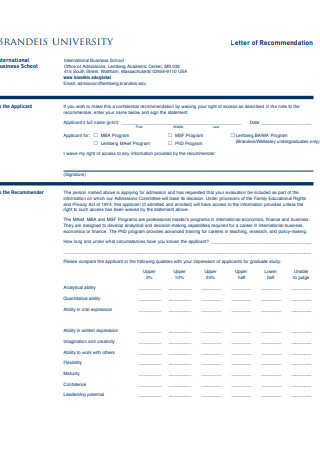
Letter of Recommendation for MBA
-
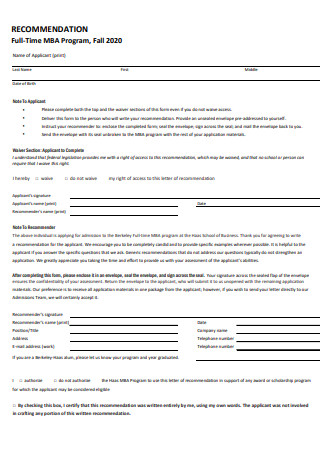
Recommendation Full Time MBA Program
-

Personal Recommendation Letter for MBA
-

Executive MBA Letter of Recommendation
-
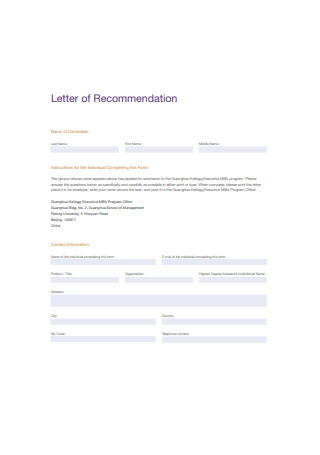
Letter of Recommendation
-

Letter of Recommendation Executive MBA Program
-

Recommendation for Admission for MBA
-

MBA Recommendation Form
-

Aalto Executive MBA Program
-

Recommendation Support in MBA Letter
-

Graduate School Request for Recommendation Letter
-

Personal Recommendation for MBA
-

References and Recommendation Letters
-
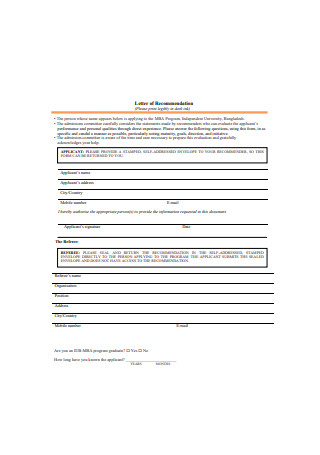
Sample Letter of Recommendation for MBA
-

Letter of Recommendation for Graduate Admission
-
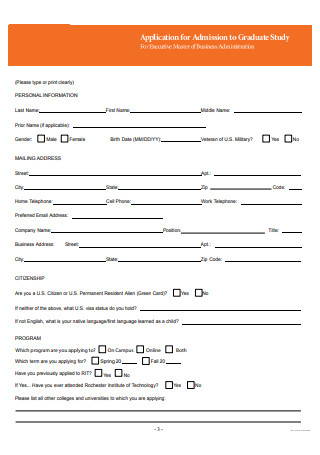
Executive MBA Program Application for Admission
-

Confidential Letter of Recommendation for MBA
-
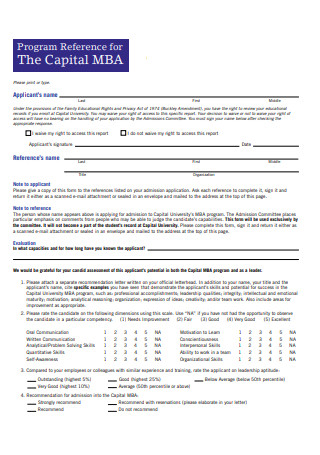
Program Reference for Capital MBA
-
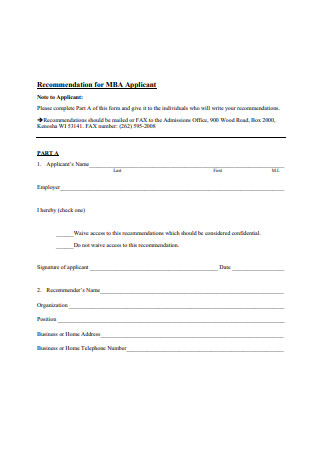
Recommendation for MBA Applicant
-
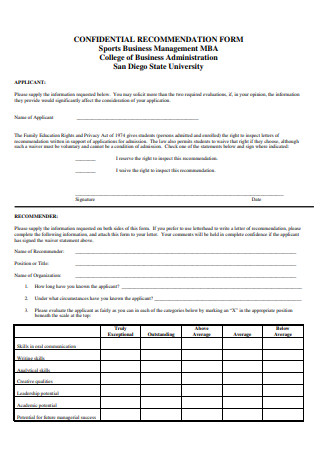
Confidential Recommendation Form for MBA
-

Basic Letter of Recommendation for MBA
-

Recommendation Form Submitted in MBA
-

Graduate Admission Recommendation Letter
-

Letter of Recommendation for the MBA Program Applicants
-

Recommendation Letter for MBA
-

Application for Post Graduate Diploma in Management
-

Graduate Admission Letter of Recommendation Form
-

Letter of Recommendation Access Waiver Form
-
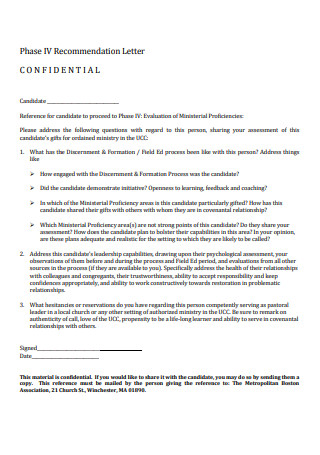
Recommendation Letter for MBA Confidential
-

Simple Letter of Recommendation for MBA
-

Letters of Recommendation for Graduate School
-

Standard Letter of Recommendation for MBA
-

Sample Recommendation Letters
-

Formal Recommendation Letter for MBA
-

Recommendation Request Letter for MBA
-

Simple MBA Recommendation Letter
download now
What Is an MBA Letter of Recommendation?
An MBA letter of recommendation is a document written by either a former academic mentor, teacher, direct supervisor, or other people of a similar disposition. It carries an 8% weight in any graduate school application and is responsible for highlighting several facets of the applicant’s overall qualifications for higher education. This can even serve as a bridge between an applicant’s self-perception and that of the admissions committee. Different schools or universities will have their own standards or guidelines, so it is likely that an applicant will have to prepare more than one letter of recommendation if he or she is serious about getting a Master’s in Business Administration.
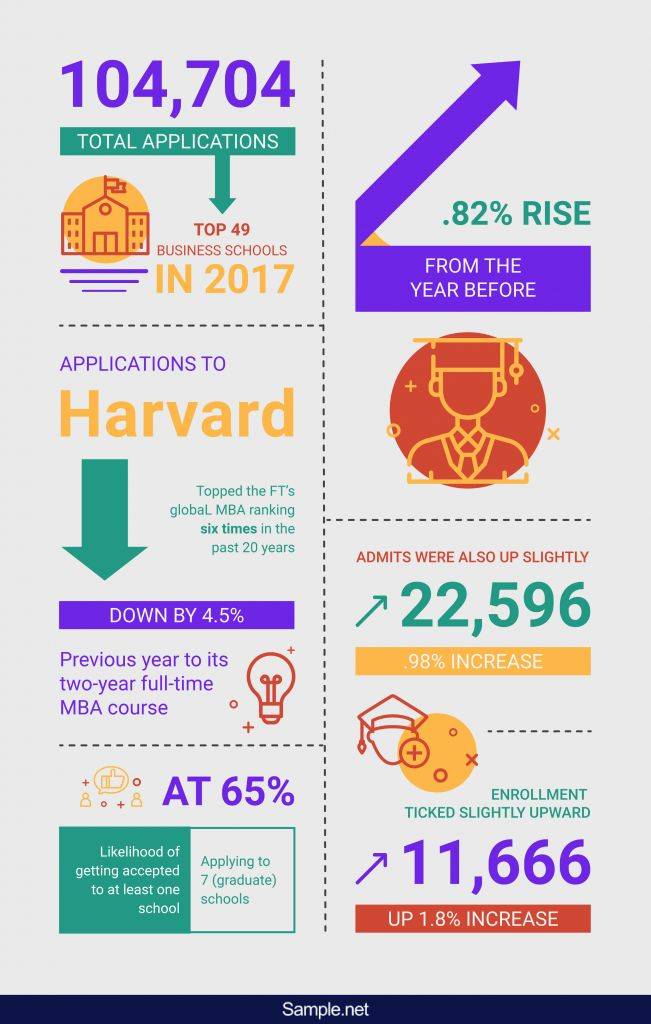
“There were 104,704 total applications to the top 49 business schools in 2017, only a .82% rise from the year before, while admits were also up slightly (22,596, a .98% increase) and enrollment ticked slightly upward as well (11,666, up 1.8%).” (Source: Poets and Quants)
“Applications to Harvard—which has topped the FT’s global MBA ranking six times in the past 20 years—are down by 4.5 percent on the previous year to its two-year full-time MBA course.” (Source: Financial Times)
“An average, the likelihood of getting accepted to at least one school peaks (at 65%) when applying to 7 (graduate) schools.” (Source: Forbes)
The Types of Letter of Recommendation
Although it is perfectly clear by now as to what an MBA letter of recommendation is, the truth is that there are several other similar documents in existence that people seek out every day. Detailed below is a list of the different recommendation letter types, their uses, and who are allowed to write them.

How to Write an MBA Letter of Recommendation
Writing an MBA letter of recommendation that is not only acceptable but also powerful and impactful is not as easy as it seems. Fortunately, there are general instructions that aim to provide letter-writers with the appropriate steps on how to create an effective letter of recommendation. Take a look at the following step-by-step procedures and see how you can accomplish this feat yourself.
Step 1: Write Down Personal Details
On the upper-right corner, you are to include your personal details. This would include your name, any title you hold, your physical address, and your email address. Below, on the left-most side of the letter, will be the details of the recipient. Include the name of the person or the name of the school, any relevant title of the person, and the physical address. Doing this shows that you have done your homework and that you are a credible letter-writer.
Step 2: Open with a Formal Greeting
Formality is always an excellent tone to take during the opening of the letter. Address the recipient directly and politely. If you are only addressing it to the school in general, you can get away with saying ‘to whom it may concern.’ In such cases, be sure to use a colon rather than a comma. Remember that this is still a business letter, so be sure to use a business letter format.
Step 3: Introduce the Applicant
In the first paragraph, introduce the applicant. Do not just do so directly. Instead, you can try to make things more interesting with a short anecdote that will illustrate just who the prospective MBA student is. The recipients of these letters receive an innumerable amount of them on a daily basis; it is up to you not to make the applicant you are writing for, seem forgettable, but the exact opposite.
Step 4: Proceed with Describing the Applicant’s Character
The next two paragraphs should involve you describing the character shown by the applicant over the years that you have known him or her. Again, the use of specific examples told via stories is a great way to do so. Also, this is the part where you detail how you know the applicant and what your specific relationship with him or her is.
Step 5: Include Relevant Achievements
Go with the character first and when that is done, you can proceed to highlight any relevant accomplishments that the applicant has to his or her name. This can include any awards won by the applicant in his or her lower educational levels, any extra-curricular accomplishments, as well as anything done by him or her in a prior professional capacity, provided that the applicant has any actual work experience to begin with.
Step 6: Conclude the Letter with a Direct Recommendation
One of the last steps would include your direct recommendation of the applicant. Up until this point, you have spent your time building up the applicant as someone who is worthy of being admitted to graduate school through examples of his or her character and achievements, both academic and professional. Now comes your definitive stamp of approval. This part does not have to be too long nor does it even warrant its own paragraph. It can be included in the last one, which leads to the last step.
Step 7: Include Contact Details in the Last Part
There is always a possibility that the admissions committee of the school the applicant is eyeing will try and conduct their own background search. By virtue of you being a letter-writer on behalf of the applicant, you effectively make yourself a point of reference for them. With that in mind, be sure to include your contact details in the last paragraph. Any follow up questions they may have for you can be made possible through this last step.
The Do’s and Don’ts of an MBA Letter of Recommendation
Even those who have written academic or job recommendation letters in the past might feel the need to improve upon their techniques every now and again. Fortunately for those people, there are several do’s and don’ts that one can keep in mind. In following these, the experienced and inexperienced alike can keep their letters as high-quality as possible.
Dos
Do accept the honor of writing if you know the applicant well enough.
For a former pupil, mentee, or colleague to come to you for a reference letter, it shows how much they value your input. This is especially true if the two of you have known each other or had an appropriate relationship for years. If you see no issues in the applicant’s record or efforts and if you are confident that you can do them justice, then this is definitely something that you should take into strong consideration. The applicant may even be so grateful that he or she will be willing to send you a thank you letter at some point.
Do have a discussion and acquire even more information about the applicant.
You might be confident enough to try and attempt the letter-writing endeavor with the knowledge that you presently have of the applicant, but it pays to gather even more just to be sure. For best results, schedule an in-person meeting between the two of you to have a discussion about the recommendation letter. There will be much to discuss, that much is certain, but there is also the guarantee that you’ll come out of that meeting knowing more about the person you will be writing about than you did going into it.
Do take specific inclusion requests into strong consideration.
The person requesting the letter of recommendation needs to have a say in what will be included in the letter. Although it would be bad practice to have them dictate everything word-for-word, if there are certain inclusions that they specifically want, then that is another strong consideration that you, as the writer, would want to take. These may be events, accomplishments, or examples that will highlight their attributes in a better light, so there won’t be any harm in including these requests.
Do include your contact information in the recommendation letter.
Even if you have done everything in your power to properly recommend the applicant to the graduate school that they are planning to apply to, the admissions committee may not be entirely satisfied for one reason or another. You will notice in numerous samples that the author normally includes their contact information in the closing paragraph. This is to not only allow the letter’s recipient the opportunity to ask any follow-up questions but also to further establish the writer’s credibility as a reference.
Do keep the length of the letter in mind.
It does not matter how long or short the average recommendation is, provided that the contents are on point. With that said, you should neither write something that is too short or something that is too lengthy. Both would have disadvantages: for the former, the details may be lacking and an insufficient letter is an ineffective one, plain and simple. For the latter, it can be bothersome to read something that is just too long, especially for those who may have other documents to attend to. A balance in terms of length with strong content included is sorely recommended.
Don’ts
Do not accept if you do not know the applicant well enough.
Even if the applicant is someone you are vaguely familiar with, it is recommended to only write recommendation letters for those whom you are more knowledgeable about. This is not just about the facts that he or she can provide you, but also in terms of how well you know the applicant’s character. If the two of you are only acquaintances at best, then perhaps it is better if you politely refuse the request. You would be doing the applicant a much bigger favor in this case because then he or she would have to reconsider whom to approach and will be more selective.
Do not tolerate any attempts at lying in the letter.
This is somewhat related to the ‘don’t’ above. Those who have inadequate knowledge of the applicant but still chooses to undertake the task of writing a recommendation letter may find themselves with far less to work with than usual. In such a case, lying is an even worse thing to do and it is something that will definitely come back to bite either of you. Alternatively, even those who know the applicant well might think that it would help if they embellished a bit. This would still be unwise because the admissions committee is likely to do their own background check on the applicant and will sniff out any lies that might have been written.
Do not shy away from any mild and necessary criticism.
You might think that recommendation letters are always going to be positive, but in truth, that does not have to be the case. Although the point is to ensure that the applicant gets accepted into the graduate program, you can also include some necessary criticism in the letter as well. However, if you choose to do so, take note that it should just be mild at best. Just enough to paint a realistic picture of the applicant.
Do not generalize the applicant with any others for whatever reason.
This is one thing that recommendation letter writers, in general, need to avoid. Generalizing undermines the individuality of any given applicant, so avoid lumping him or her together with various other people or with groups. This is also a good time to point out that generalizing in ways that involve gender, race, sexual orientation, political views, and others, is an unfortunate way of setting applicants up for potential discrimination down the line. So all in all, do not generalize.
Do not neglect the possibility of further edits.
Even when you have finally finished the letter of recommendation, there will be a chance that you may have to go back to it for one reason or another. With that said, do not discount any chances of edits or revisions down the line. It helps to be prepared, so keep in close contact with the applicant until such a time when the two of you can be sure that there won’t be any more changes needed to the recommendation letter.

As simple as they may seem at first glance, there is definitely far more to MBA letters of recommendation than what initially meets the eye. Each bit of knowledge about it that you absorb can make you one step closer towards your ultimate goal—be it academic in nature, employment-related, or otherwise. Be sure to take advantage of the many high-quality resources that you have at your disposal. Should you decide to acquire an MBA recommendation letter template, we guarantee that all you need to do from there is edit in the necessary information and print it out once finished.
